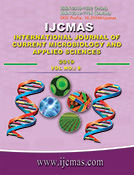


 National Academy of Agricultural Sciences (NAAS)
National Academy of Agricultural Sciences (NAAS)

|
PRINT ISSN : 2319-7692
Online ISSN : 2319-7706 Issues : 12 per year Publisher : Excellent Publishers Email : editorijcmas@gmail.com / submit@ijcmas.com Editor-in-chief: Dr.M.Prakash Index Copernicus ICV 2018: 95.39 NAAS RATING 2020: 5.38 |
The nature and extent of genetic diversity were assessed among 57 pigeonpea accessions comprising release varieties, farmer varieties and reference varieties. All the accessions were grouped into eight different non-overlapping clusters. Among them cluster I, having 17 accessions, emerged with highest number of entries followed by cluster V with 9 accessions, cluster III with 7 accessions, cluster IV with 6 accessions, cluster VI, VII and VIII constituted by 5 accessions each while cluster II, comprised 3 accessions, had least number of entries. The highest contribution in manifestation of genetic divergence was exhibited by 100-seed weight followed by days to maturity, plant height and days to 50% flowering. The hybridization between entries belonging to cluster pairs having large inter-cluster distance and possessing high cluster means for one or other characters to be improved may be recommended for isolating desirable recombinants in segregating generations. In this context highest inter-cluster distance was recorded between cluster V and VII followed by cluster IV and VI, IV and VII, III and VII while cluster I and III had lowest inter-cluster distance. The promising accessions identified were Bumba Tumur, BDN-2, Chaita Arhar, BSMR-736, Karanja Tuar, Dehati Arhar Lal and Belianga of cluster III; UPAS- 120, Paras, Manak, Dehati Arhar-2, Pusa-992 and Vamban-1 of cluster IV, Ram Arhar, HJP-7, Agahani, Manika Arhar and HJP-9 of cluster VI and NTH-77, Lal Rahri, Desi Arhar-1, Arhar Manpur Pahadi and Rehhe Arhar of cluster VII for exploitation in hybridization programme for development of superior pigeonpea cultivars.
 |
 |
 |
 |
 |